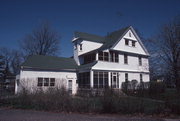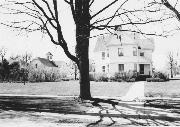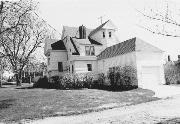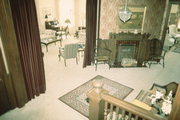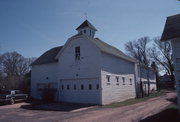Property Record
111 S DAKOTA AVE
Architecture and History Inventory
| Historic Name: | Orville W. Mosher Home |
|---|---|
| Other Name: | |
| Contributing: | Yes |
| Reference Number: | 47171 |
| Location (Address): | 111 S DAKOTA AVE |
|---|---|
| County: | St. Croix |
| City: | New Richmond |
| Township/Village: | |
| Unincorporated Community: | |
| Town: | |
| Range: | |
| Direction: | |
| Section: | |
| Quarter Section: | |
| Quarter/Quarter Section: |
| Year Built: | 1887 |
|---|---|
| Additions: | |
| Survey Date: | 1983 |
| Historic Use: | house |
| Architectural Style: | Queen Anne |
| Structural System: | |
| Wall Material: | Clapboard |
| Architect: | Gilbert and Taylor |
| Other Buildings On Site: | |
| Demolished?: | No |
| Demolished Date: |
| National/State Register Listing Name: | New Richmond West Side Historic District |
|---|---|
| National Register Listing Date: | 5/31/1988 |
| State Register Listing Date: | 1/1/1989 |
| National Register Multiple Property Name: |
| Additional Information: | #650: Carriage House Description: There is clapboard and wood shingle exterior fabric on this 2 1/2 story residence. The foundation is rock faced cut stone and is unpainted. The roof shape is basically cross gable with dormers in the rear. It has asphalt shingles covering it. The plan is basicillica shaped. There is a basement. The front section (or ell) has two sets of corner windows on the first and second stories beneath a pedimented gable. This pedimented gable, and all others extends out past the building facade for about one foot. On each floor is a window between the corner windows. The second story windows are 6/6 and first story are 1/1. The gable has a small oval window and wood shingle exterior fabric. Small dentils are around the box gable cornicxe. A small pent roof separates the first and second stories right over the first story window heads. This pent roof has triangular shaped wood shingles and dentils on its edge. This continues around the perimeter of the house. This line also seperates the wood shingles on the top 1 1/2 stories from the clapboard lower story. The exception to this is on the front ell where clapboard begins under the second story window sills. To the north of this ell is the front entry under a one story shed roof porch. The porch has fluted column and pilasters with capitals. Until recently this porch was semi-circular but rotting wood caused it to be redone. Above this is a square window with a wood frame and entablature head. To the south of this same front ell are two windows, one on the first story (1/1) and one on the second (6/6). The south side of the house has a pedimented gable over an ell similar to the front one except that there is a paired window with an entabulature head frame. Two windows on each story are on this part. To the west of this are screened-in porches (SW corner of the house) with shed roofs. On the north side of the house is a smaller pedimented gable with shingles and dentil molding around the box cornice. Brackets are below the overhang on this side. A paired window is below this. At the second floor level are urn-shaped supports where the second story overhangs. To the west of this is a small one-story ell with a shingled gable. On the west side of the house is a shed roof dormer and a three-sided turret or dormer with a window in each side and a pedimented gable. A new one-story garage has been put on here. Separate from the house is a large carriage house with clipped gable roof and a cupola (SC 35/25). It is on the SW corner of the property. The exterior fabric is wood and there are first-story windows. Landscaping consists of short hedges around the house and a few large trees near the property edges. The lot is a corner one. The visual impact of the house as you enter the neighborhood on West First Street is outstanding. The corner lot with little landscaping to obscure it draws one's attention to the massing of the house of the house and the multi-gabled roofline. It is in excellent condition and has retained its architectural integrity. In size and character this residence fits in well with the neighborhood. House plans for O.W. Mosher show that this residence was designed by Cass Gilbert and James Knox Taylor of Saint Paul. They were in partnership there from 1883 to 1892. Significance: The house is an excellent example of the early stick style of this time period. There are still elements of the Queen Anne style to be seen in the house but the surface material and and slope of the roof and gable are characteristic of this style. Because of the excellence of Gilbert's design this residence has local architectural significance as being representative of the early stick styling of Cass Gilbert. Background: Orville Watson Mosher (1853-1933) moved to New Richmond in 1879 to become the first school principal. He married another teacher, Delia Tobie (c.1851-1923), and had four children. Mosher promoted the idea of having a graded high school but resigned his position in 1883 shortly before this occurred. At this point he began what would lead to his becoming a pioneer industrialist in New Richmond by buying into one of the city's grain mills. In 1890 he formed the Northern Grain Company. This company eventually provided the mills with a line of elevators to store and ship grain. The elevators were leased to the mills. After the June 12, 1899, tornado damaged the New Richmond Roller Mills they were reorganized with Mosher as the president. He continued as president until his death. The flour mills had been in the city in one form or another since 1867. After a 1916 fire destroyed the mills, they were rebuilt with steel instead of stone rollers. Around this time the mills began buying up other local mills and elevators, consolidating their hold on the local flour and grain market. Huntingdon Power was also organized to provide water and electric power to the mills. It was later sold to the Wisconsin Hydroelctric Company. Besides reorganizing and modernizing the mills, Mosher was active in New Richmond's civic affairs. He was on the Board of Public Works and the committee responsible for building the county asylum in 1897. In 1898 Mosher was a St. Croix County assemblyman and in 1899 a Republican state senator for Pierce and St. Croix Counties. He was in charge of relief work after the 1899 tornado and represented the city in Madison in efforts to obtain aid. In 1887 O.W. Mosher built the house at 111 South Dakota Avenue. It was designed by Gilbert and Taylor of St. Paul. The 9 March 1887 St. Croix Republican reported that stone was being quarried for Mosher's residence. Oakes' quarry was 1.5 miles south of New Richmond at this time and a possible source of the foundation stone. Another house was on this site and was offered to anyone who wanted to tear it down or move it. It was soon torn down by a Mr. E. Brevold. On April 13, 1887, the local paper reported that the house plans were complete and that "in size and style it would be second to none." The plumbers came from St. Paul and carpentry work was supervised by Q.W. Church, a local man. By September surplus trees were being cut down and lumber for a sidewalk was being laid down. In November the family moved in. The estimated cost was $10,000. On January 4, 1888, a housewarming party was given, after 100 invitations were sent out. Significance: The New Richmond Roller Mills exist today as Doboy and Domain, a diversified company. They have local significance because of their association with the community's development and the growth of the milling industry. Mosher had a pivotal role in the early 20th century modernization and growth of this company. At this time (1887-1933) he was living in the house at 111 South Dakota Avenue. Because of Mosher's prominence the house is historically significant for its association with him. |
|---|---|
| Bibliographic References: | New Richmond News 1/23/1997. New Richmond News 7/24/1997. New Richmond Walking Tour brochure, 2000. |
| Wisconsin Architecture and History Inventory, State Historic Preservation Office, Wisconsin Historical Society, Madison, Wisconsin |

